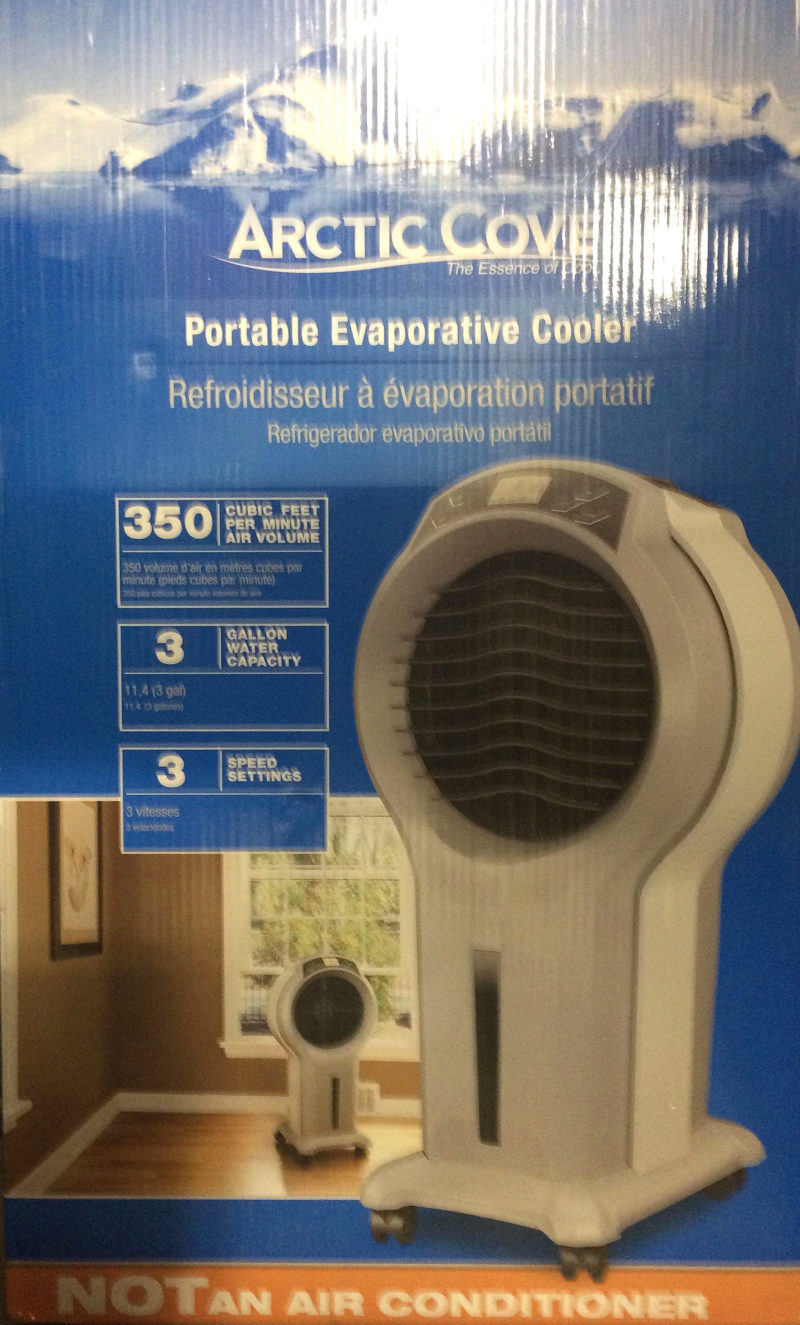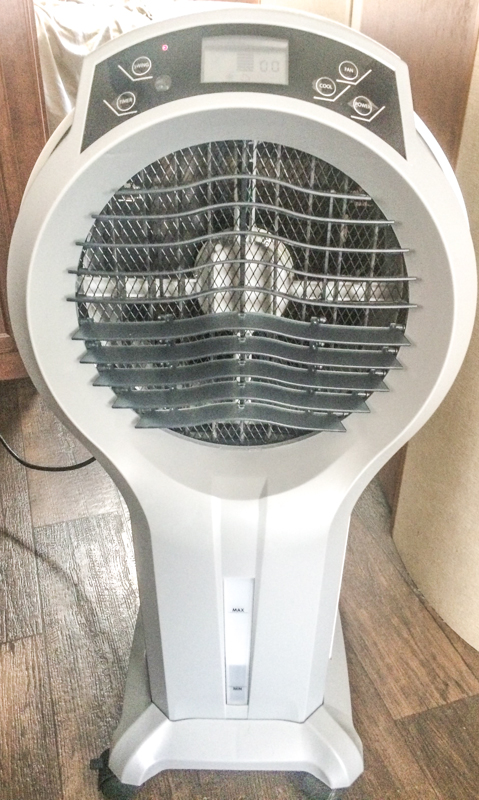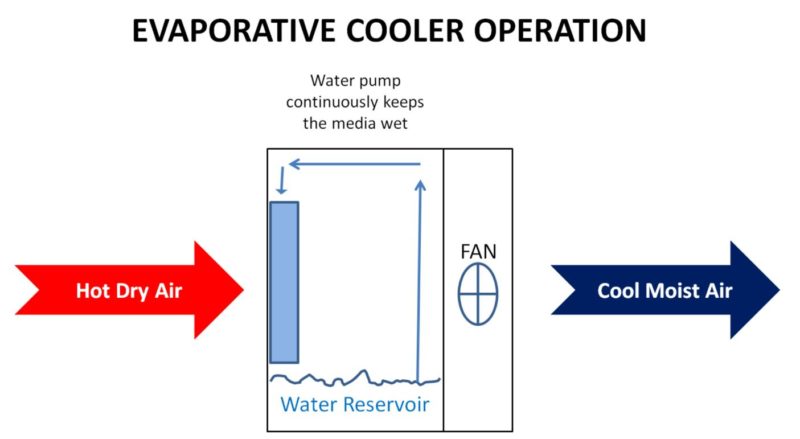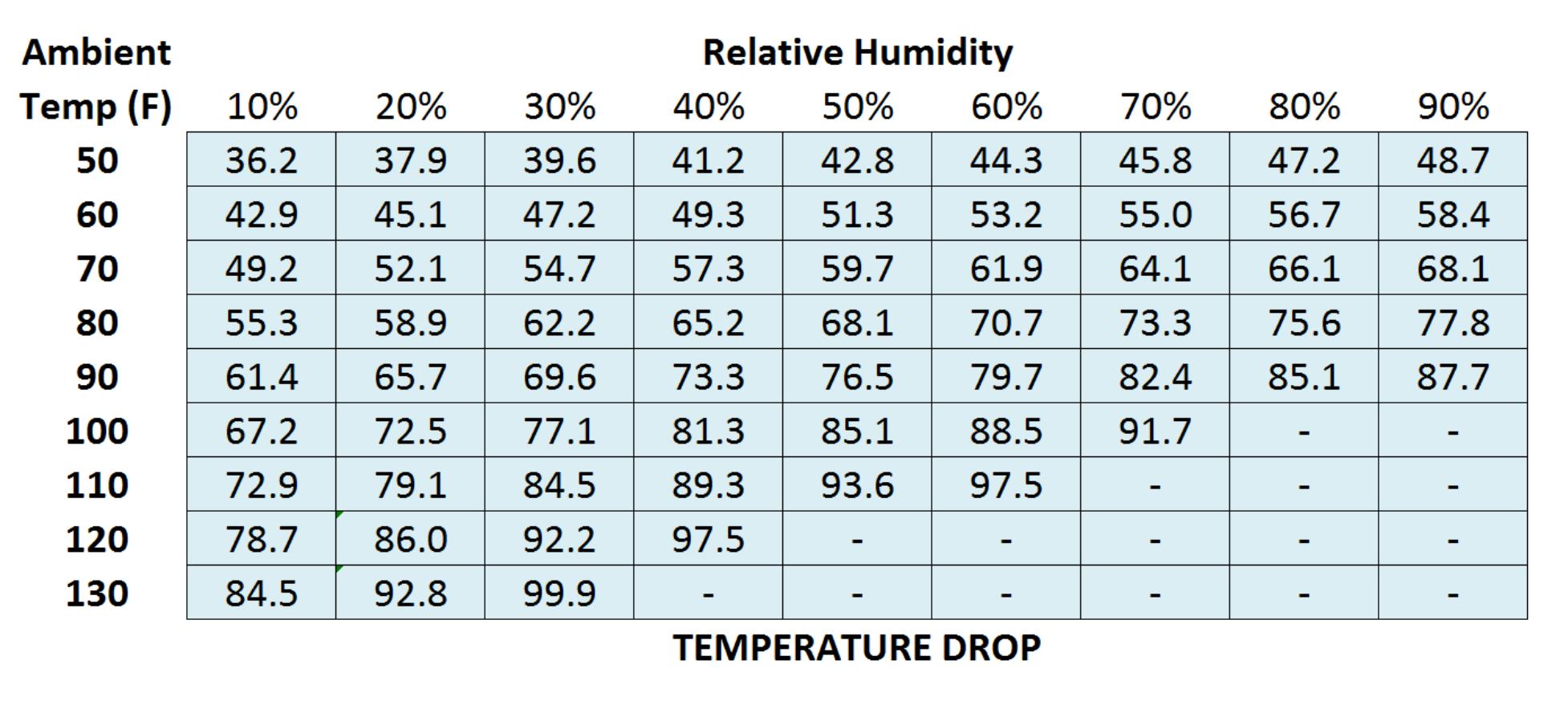I have camped in the desert during summer without air conditioning many times. In our local deserts, temperatures do occasionally hit 120F and once in a while even higher. See this post where I re-packed our wheel bearings in 123F temperature. The rare occasions we patronize a campground with electrical hook-ups is usually when we take our inflatable boat to the lower Colorado River in the middle of summer.
Old Age is Creeping In.
Staying cool in the hot desert during the day is simple: just stay in the shade. But as I get older, it is getting more difficult for me to sleep when the nighttime temperatures are 90F or higher. This June we spent a couple of weeks at Lake Mead and most days were above 110F and a couple hit 114F. Anticipating this, and not willing to stay in a parking lot campground with hook-ups away from the lake and in civilization, I came up with an idea – a portable evaporative cooler (aka swamp cooler).
Now, I could buy a generator, which is expensive and more importantly noisy. So that was out based on principle and philosophy. Being familiar with evaporative coolers, I first needed to do some simple math.
Watt’s Law
If you follow my blog you know we have a solar system and an inverter that can provide 2,000 watts of continuous 120 volts AC (alternating current). Why not use that? Because numbers are our friends.
Watt’s Law tells us that:
P = V x I or V x I = P
Where P = Watts, V = Voltage, I = Amperage
Dometic Rooftop Air Conditioner
Can we run our 13,500 BTU air conditioner with our solar system? Let’s do some math using Watt’s Law. Our A/C unit is rated at 120 volts @ 15.1 amps. So the watts are:
120 volts x 15.1 amps = P
120 x 15.1 = 1,824 watts
Okay. Theoretically the inverter can handle the A/C. Since the A/C has a surge when first started and the inverter is rated at 3,000 peak watts so that is probably going to work also.
But…
Can we generate enough amps? Pay attention if you haven’t done this kind of math, many campers get confused. To generate 120 volts to run the A/C, we need to draw it from our 12 volt DC (direct current) battery and solar system. Without explaining how this works, let’s just do some additional math using Watt’s Law again. Since we are getting our electricity from a 12 DC volt system and the inverter is changing it to 120 AC, we will substitute 120 volts with 12 volts. Watts remain the same.
12 volts x (?) amps = 1,824 watts
12 volts x 152 amps = 1,824 watts
Wow! 152 amps!
Nick’s Rule of Thumb: when powering 120 volt appliances with a 12 volt inverter, the required amps is 10 TIMES the 120 volt amperage specification.
Okay, our solar panels only put out a little over 15 amps in summer in the middle of the day. But we aren’t going to use the A/C during the day, remember? I just want to use it at night when there is no sun. Can we run the A/C off the battery?
Our battery bank, when fully charged, has 226 AH (amp hours). But we can only use 50% of this capacity because going lower too often will significantly decrease the battery life. See Is Your Camper Killing Your Battery.
Our useful capacity is 226 AH x 50% = 113 AH. Amp Hour means how many amps are available in one hour. So in this case we can use 113 amps in one hour, or 11.3 amps over a 10 hour period, etc. You should get the idea. Since we need 152 amps to run the A/C, we can figure out how many hours we can run it by dividing the Amp Hours by the Amps need to calculate it, which is 113 / 152 = .74 hours or about 45 minutes.
Now you see why I was interested in an evaporative cooler.
Watt’s Law and an Evaporative Cooler
So my search for an evaporative cooler had 3 requirements
- Lowest amps possible
- Able to cool the camper’s living room with the bedroom door closed in case we want to use it during the day (about 170 sq ft – but if one is going to stay in the camper all day they might as well stay home)
- A water container that can be removed from the cooler for refilling (don’t want one that requires a hose)
Using my friend, Mr. Google, I located an Arctic Cove cooler at Home Depot rated at
- 0.5 amps
- cools 175 square feet
- a removable container that holds 3 gallons of water. If the cooler runs out of water the unit beeps, turns on a warning icon, and turns off the pump so it is not damaged. 3 gallons of water lasts for about 6 hours.
Cost was $179 plus tax.
So let’s do the math for a 12 volt system:
If you remember Nick’s Rule of Thumb, we just multiply the 120 volt amps by 10. So, 0.5 amps X 10 = 5 amps.
V X I = P
120 volts x 0.5 amps = 60 watts
12 volts x 5 amps = 60 watts
Do we have ample battery capacity?
If we run the cooler for 10 hours at 5 amps we will use 50 amp hours. Our usable battery capacity is 113 amp hours. We’re good to go. Maybe.
The Real World
5 amps consumption assumes that we are not using any other consumers and it assumes our inverter is 100% efficient, which it isn’t. While running the cooler our amp usage varied between 7.3 and 7.8 amps. That was acceptable and the battery bank was recharged to 100% full by noon of the next day.
Does it Work?
Evaporative coolers only work well in low humidity areas. Deserts are good candidates for them. A brief description of how they work is in order and how they are different than a true air conditioning unit.
Although I can explain how an A/C system works in detail, I’ll just summarize: an air conditioner removes heat and dehumidifies. That’s right; it doesn’t cool the air, which is why you want all the windows and doors closed. Removing heat is a critical concept.
An evaporative cooler takes warm air and passes it through media soaked in water, and as it passes through the wet media the air absorbs the water and as the water evaporates it cools off. This water is blown through the living space and requires an open window to circulate the air out of the living space. To summarize: an evaporative cooler cools the air and adds humidity to the air.
An evaporative cooler’s fan pushes much more air than a typical air conditioning system because a large airflow is required. The airflow alone will make you feel cooler. Below is a table demonstrating how a properly sized and efficient evaporative cooler will perform based on the ambient temperature and relative humidity.
At night we put the cooler in the doorway of the bedroom and opened the window. The cooler draws the hot are from the living room area and blows cool air into the bedroom.
To use it in the living room, we would close the bedroom door, open the window in the living room opposite the opened entrance door and place the cooler in front of the entrance door to draw outside air and pass it through the cooler. We haven’t used it this way yet, but the specs are just at its limit for the size of the room. I would probably want a large cooler.
Overall, we are happy with the cooler based on our needs. We are not going to keep it in the camper full time. But will take it with us for those summer desert camping trips to places without hookups.
You would not want to go this route if you camp in high humidity.



